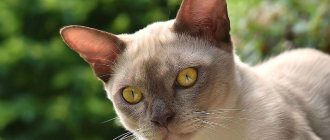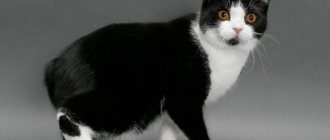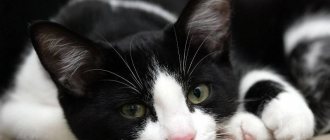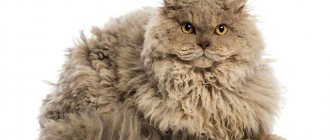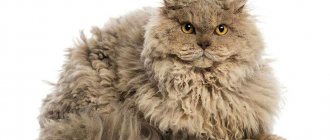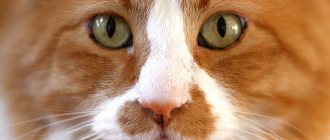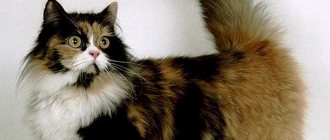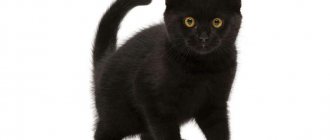Mystery of color
The history of the appearance of these animals has distant Phoenician roots. In those days, the Phoenicians treated black felines as amulets.
The animals, invisible in the dark, were excellent at hunting rodents at dusk, so conditions were created for them to reproduce. In ancient times, packs of cats were even kept in temples. However, over time, when the population of cats grew, they were persecuted - after all, many were frightened by flocks of burning eyes moving in the dark. Seeing such a spectacle, people in fear began to associate black purrs with otherworldly forces. And women who kept such pets were called witches and burned at the stake.
Salvation in such a situation could be at least one white hair in the animal’s dark fur. So, the breeding of the black color gradually began. Black and white has replaced it.
Black color and eye shade
Kittens are usually born with blue and blue eyes. At the same time, at 3-4 months it begins to change and by the age of one year it acquires its true color.
Important! Geneticists say that eye color depends on the location of eye pigmentation. If the anterior zone of the eye is more pigmented, they become yellow. In cases where the pigment accumulates in the posterior zone, the eyes get a green or green-brown tint.
Green eyes
In ancient times, a black cat had green eyes. However, geneticists have made every effort to get rid of the natural color and even breed a black cat with blue eyes. But today, grass-eyed and emerald-grass-eyed purrs are very difficult to find.
In breeds where pedigree is not preserved, eye color does not matter. But if we look at the pedigree, then a cat with green eyes will be present in tortoiseshell particolors, tortoiseshell tabbies, particolors and solids.
Yellow eyes
This color is the most common and is characteristic of almost all breeds of black cats. Differences can only be in shades: amber, sand, orange, copper, olive and emerald.
Blue eyes
This color can only appear in kittens, but with age it changes to yellow or green. A black cat with blue eyes is found only among representatives of the Ojos Azules breed.
Breeds with acceptable black coloration
In nature, this color is not unique among cats and is often found in any breeding groups. The dominant B gene is stably present both in native breeds (which were formed under natural conditions) and in various hybrid communities or among outbred animals.
big black cats coexist with equally charcoal-shiny homeless strays, and this picture never surprises anyone.
American Bobtail
A rare breed of tailless cats. Their breeding began in the 60s in Arizona and continues to the present day. Among the parents of the American Bobtail are Siamese, Burmese, and Himalayan cats. A distinctive feature of the breed is the absence of a tail, and the color fades into the background.
More often than others, grey-red kittens with a tabby pattern (stripes and spots) are born. Fluffy black cats with a small overgrown tassel in place of the tail are less common, but it all depends on the parents and genetic predisposition.
The mixture of different breeds in the origin of the American Bobtail suggests the appearance of offspring of the most unusual colors, among which there are both solid black colors and combinations of black and white.
Siberian breed: black cat with green eyes
An indigenous Russian cat, which can be recognized as a national treasure of the country. The history of origin is unknown for certain, like most other breeds. But rich long fur, dense undercoat and adaptability to harsh climates indicate that the animal has perfectly adapted to its natural habitat.
The solid colors of Siberians come in two colors: red and black. But if the red tones are intersected by a tabby pattern (stripes, spots or blurred marble), then the coat of a long-haired black cat looks very impressive. In total there are more than 200 combined color options.
This is interesting! Siberian cats became the founders of the Neva Masquerade subspecies - a long-haired breed with a characteristic point mask in red or black shades.
Oriental cat
Oriental cats are champions among black breeds in terms of gracefulness. They are very graceful and sophisticated, on high slender legs, with an elongated wedge-shaped muzzle on a long neck and slightly slanting green eyes. In this color, the wool is evenly dyed along the entire length, from the root to the end.
Among representatives of this species, smooth-haired black cats are also often found.
Devon Rex
Devon Rexes are presented in two categories:
- Like many new breeds that gained official recognition in the 20th century, all modern Devons are descended from a kitten found in the litter of a mongrel cat. He had very large ears and curled fur, for these qualities the cat received the name Kirli (curly).
- It is a rare case when literally everything is known about the first animal in the group - Kirli was a black cat with eyes the shade of yellow amber.
Devons are very active pets - they love to climb onto the owner's neck and sit on his shoulders.
Like other representatives of the “eared” group, they are often called elves, hinting at “extraterrestrial” genetics. Among the popular black cat breeds, Devon cats are not considered. The population is small and black is not the most common color.
Turkish Angora
For more than a century, Turkey has had a program to preserve this breed as a national treasure. We are talking about a classic Angora cat with long or semi-long white hair and multi-colored eyes - yellow and green.
These animals began to be called Angora due to their very soft hair, by analogy with the well-known downy goat breed.
The spread around the world and the efforts of breeders have not benefited the classic white color. It is gradually giving way to other colors, and it is not surprising when black-brown cats with different-colored eyes and a fluffy long tail appear at exhibitions.
It must be admitted that in the pure black version, the shaggy Turkish Angora looks very impressive and rich.
Norwegian forest
Representatives of the aboriginal breed live in Northern Europe. One of the legends about its appearance connects the harsh, unpretentious Norwegians with the pampered southern Angora breed, which has adapted to living conditions in a cold climate.
The forest cat is large, with a double coat, dense undercoat and winter “decorations”: a mane, bib, whiskers and warm pants on the hind legs.
The portrait is completed by neat erect ears with tassels and thick pubescence on the inside of the auricle.
Norwegians are large animals that mature only at 4-5 years of age. Any color is allowed in the breed except those that indicate an undesirable crossbreed: fawn, cinnamon, chocolate and others. Large all-black cats are rare, but black and white cats with thick undercoat are common.
This is interesting! The indigenous qualities of the Norwegian forest cat are protected by an international association. Their out-of-breed crossings are allowed only with a separate permission from WCF.
American Curl
There are representatives of this breed with semi-long and short hair. A distinctive feature of Curls are their ears - wide at the base, semicircular at the top, with reverse folded ears at an angle of at least 90°.
There are no separate requirements for coat and eye color, with the exception of color-point colors with a characteristic blue eye color. In other colors, shades from brown to light hazel are acceptable.
Representatives of this breed with pure black hair are rare. The most beautiful black cats come from short-haired parents. Long-haired pets are traditionally presented in black and white.
Important! The American Curl should not be left alone with small children. Careless caresses can damage the fragile structure of the curled ears.
Manx
The main distinguishing feature of the Manx cat is the absence of a tail. The length of what is left of it cannot extend below the hock joint of the hind legs. But more often there are animals with a 3-7 cm “process”.
When breeding animals, they must select one of the parents with a longer tail - two tailless genes lead to the death of the offspring.
Manx cats are allowed any coat color, except for the color-point varieties. Black kittens are rare, but white or tortoiseshell cats are born consistently.
Cymric
The Cimmerian breed is a semi-longhaired version of the Manx. Breeders united kittens with long hair into a separate group, and then they were recognized by international felinological unions.
Black tailless Cymric cats are born with yellow or green eyes and the typical short "broom" for a tail. They easily adapt to the family and get along well with children and pets.
Coal Bengal
To call this cat black is wrong, but to describe it in any other way is stupid. Bengals are an interspecies mix. Their ancestors are domestic cats and wild Bengal cats. The hybrid received an incredibly beautiful spotted color - contrasting black spots on a golden background.
In appearance, they resemble small leopards with a cute face and an independent character.
The Charcoal Bengal's main coat color is bleached black, and the spots and stripes are less pronounced. Another feature of the animal’s appearance is the mask on its face. Its lines are wider than those of standard-colored cats.
Charcoal Bengal charcoals do not have any privileges in the standard and are subject to general expert rules.
Chausie
Another hybrid of a domestic cat (this time an Abyssinian) and a wild jungle cat. The desire to breed a harmless animal with the external signs of a predatory animal does not leave breeders, and they are finding more and more sophisticated ways. Chausie (housey) is another experiment in this chain.
This breed has only three colors:
- silver;
- tabby;
- black.
It is not recommended to keep Chausies in an apartment, as they need space to play and move.
Black cat breeds
Black cats come in different breeds. Let's look at the most popular ones.
Persian
This breed is characterized by beautiful long hair, a snub nose, a large head, round ears and expressive orange/yellow eyes. A black fluffy kitten or a black fluffy cat has a powerful appearance thanks to its large back and paws, and a developed chest. Persians have a thick undercoat and long, thin bristles up to 20 cm long.
When you pet such a cat, you get the feeling that you are touching a silky soft pillow. In character, they differ little from sofa cushions, as they are lazy, inactive, do not like to run around, and prefer to lie in a chair or on the sofa in the company of their owner.
But it is worth noting the affectionate nature of the animals. They show sincere affection for all residents of the apartment. Persians will never meow annoyingly, begging for something from the owner, but will only peer intently into his eyes.
Important! An animal cannot be alone for a long time and may become bored without communication.
British
The breed was developed in Great Britain, hence its name - British. The animal was created by crossing a long-haired Persian with a simple street relative. The modern Briton is more often found in red color, less often in black. The breed is quite large, graceful, and has a proud, aristocratic appearance. The thick fur resembles a plush toy.
Breeders have been improving the breed for many years. The result was a black massive fluffy cat of a strong build with a wide chest and short legs.
A distinctive feature of the breed is the head, framed by a fold. It is this that allows one to distinguish a Briton from similar relatives. A straight, thick tail, rounded at the end, should be equal to the length of the animal’s body.
The cat's fur also looks special. It is thick, exceptionally soft and stands straight up without pressing against the body.
Important! The animal has a unique character: along with friendliness, it manifests persistence and willfulness.
Cats are sociable, playful, will happily chase the “mouse” and will join in any play situation. The Briton does not like shouting and assault, and with an aggressive attitude, the owner may forever lose the love of the animal. Against the background of a large head with strong jaws and chin, the wide but short cat’s nose looks unusual.
Scottish fold
The breed is also called the Scottish Fold due to its small ears tilted forward. The breed was developed by crossing British cats with short plush hair. The Scottish Fold is most often found in gray color, less often you can find black color.
The breed is characterized by friendliness, kindness and devotion. But it is worth noting that when living in a house with several people, the animal chooses one owner. This is especially noticeable when the cat walks around the apartment following only one person, and also sits on his lap.
In communication, the animal shows obedience and low activity. Therefore, there are no difficulties with the content.
Maine Coon
The breed is a representative of the largest domestic cats. Males gain on average up to 15 kg of weight, females - slightly less. This species is characterized by a powerful, muscular body, large paws and soft, thick fur. The fluffy tail reaches a length of up to 50 cm. Triangular ears clearly stand out on the massive head of a black cat with small green eyes.
The animal is characterized by good health and a peaceful, balanced character. Therefore, there will be no broken dishes or overturned furniture in the house. And the animal will never snap at a child’s cuddling and unpleasant touches.
Important! Cats of this breed are easy to train, respond to voice commands, and love order. Therefore, they know the location of their tray well.
An interesting feature of the animal is timidity and poor resistance to stress. Therefore, breeders immediately warn household members about the need to maintain peace in the house. This is the only way to save your pet’s nerves.
Oriental
This breed was officially registered in England in the 20th century. Shorthair and Siamese breeds were taken for crossing. This is how a small, muscular and rather thin breed with dense hair and large ears appeared.
The magic of purebred cats in black
Today, black cats are not uncommon, although breeders of purebred animals say that it is quite difficult to obtain a perfectly even color. This is connected, of course, with genetics. A cat will be one color only if both chromosomes in the cell are responsible for the same color - in our case it is black. And for this, exactly such a chromosome must pass from both mom and dad. However, often the parental genes turn out to be different, while the same ones are considered rare.
On a note! For cats, the natural color is considered to be derived from two pigments: black and yellow. As a result of this mixing, the wool turns out to be gray, often with dark stripes, or variegated. And black color is formed as a result of mutations that occur at the gene level!
Next, we suggest looking at photos of the most charming black cats of various breeds.
- Persian cat. Due to the fact that the outer coat and undercoat of representatives of this breed are different in length, their black coat shimmers very beautifully. At the same time, it is very important that the color is uniform, like a raven’s wing, from the roots to the very tips and always without gray undercoat. The eye color of Persians with this color is either smooth copper or dark orange. When keeping exhibition specimens, it is important to remember that prolonged exposure to sunlight can have a detrimental effect on the color, so it is advisable not to let the black Persian cat go outside in clear weather and not allow him to bask on the windowsill for a long time. In kittens of the Persian breed, the black color is often uneven, but this is not a reason for culling, since it usually evens out over time
- British cats. A black British cat may well be either short-haired or long-haired. These animals in their plush coat are undoubtedly very beautiful, but at the same time the color itself is considered quite complex: each hair must be completely dyed and at the same time in a very deep, rich color. The nose and paw pads of this color are also black. As a result, a black haze absorbs the entire animal, only the eyes are visible - copper, bright yellow or orange. A Briton can get the ideal black color if there is a small number of lilac and blue colors in his pedigree
- Scottish fold. In Scottish Fold cats, the black color is one of the most spectacular, when copper eyes literally shine against the background of shiny fur. This color is a solid color, and the color, as in the previous case, affects not only the top coat and undercoat, but also the nose and paw pads. The black fold-eared cat is elegant and quite bright in its own way, especially when it is cared for according to all the rules - in this case, the animal’s fur will always be shiny and lively, which will make its color especially attractive. With proper care and a balanced diet, the black Scottish Fold's coat will shine even in the twilight
- Siberians. The black Siberian cat is extremely rare. The color of the coat in this case is very dense, literally charcoal. Due to their luxurious thick coat and impressive size, these pets look quite large. However, this is still the same measured Siberian with his own special personality: he is affectionate, moderately playful and, as always, courageous. The luxurious feathering on the tail and thick collar give the black Siberian a royal charm
A true panther among domestic cats
This is the Bombay cat. Her fur has absorbed all the depth of black color, while it is impeccably smooth and shiny. When this animal moves, it appears as if the resin is slowly boiling. But the Bombay cat stands out not only for the ideal color of its black coat - it also has a rather bright temperament and a pronounced personality.
The Bombay cat has completely black fur and penny-colored eyes.
Temperament and behavior
Cats have always been independent and mysterious creatures. Their behavior is often related to their temperament. Each breed has its own personality traits. However, despite the variety, each black domestic cat will be unique, so it will exhibit individual behavioral characteristics.
Important! When choosing a friend, it is worth finding out what kind of temperament he has in order to carry out proper upbringing in the future.
Experts in cats, just like in people, distinguish several types of temperament. This:
- Choleric cats. They are highly active, sociable and aggressive. Therefore, in stressful situations with improper upbringing, they can show anger and cause problems at home, on the road or at an exhibition.
Education should be carried out in calm and calm tones; punishment, shouting and knocking should not be allowed.
- Phlegmatic cats. Animals are characterized by an inhibited reaction. They are calm, compliant, patiently withstand the “bullying” of small children; as adults, they do not show much activity. To prevent the animal from becoming fat, the owner must constantly include it in the game.
Phlegmatic people are good reproducers, since with their patience and indifference they are able to break the tenacity of any cat. When educating, you can resort to shouting, slamming with a newspaper, and even smacking him by the collar. This will be enough for all commands to be executed subsequently.
- Melancholic people. Such cats are characterized by an unstable psyche, increased emotionality, jealousy, resentment, fearfulness and attachment to the owner. When raising them, it is necessary to show affection, calmness, not shout, but talk more with the animal. This is how a sensitive and devoted friend grows up, who will definitely support you in difficult times and in a bad mood.
Melancholic cats often become poor reproducers, remaining loyal to their owner.
- Sanguines. Such animals are characterized by a fairly balanced character, they are calm and cheerful, easily get along with family members, and do not require special maintenance. Sanguine people are not afraid of new people, but on the contrary, they make contact and easily get involved in the game. In new conditions, without being afraid, they begin to study the situation and territory.
Features of care
All breeds of black cats require almost always the same care. Need to:
- organize proper nutrition. In order for the animal’s health to be strong, the diet should include meat, cereals, vegetables (raw and boiled), oat porridge, buckwheat, pearl barley, wheat cereal;
- develop appropriate education. Raising a cat should correspond to its temperament;
- carry out veterinary maintenance. To do this, you will need to visit a veterinarian 3 times a year for a general examination, and if health problems arise, immediately seek qualified help;
- observe hygiene standards. For this purpose, the apartment needs to allocate a place for food, an area for a tray, an area for relaxation and games. You will need to organize a scratching post for the animal. The pet should be bathed every 2 months with special shampoos, the coat should be dried with a hairdryer and combed with a soft brush.
- create favorable conditions for the pet's life. Here, an important place is given to communication with animals and games. Contact with a cat will allow you to find a true friend in him.
Myths and signs about black cats
Since ancient times, black cats have been attributed various mystical abilities. Some people treat them with admiration, while others call them a source of evil.
The Egyptians believe that the goddess Bastet sent them a black cat as a symbol of moonlight.
The ancient Celts symbolized her with the goddess of the hunt, Artemis. And for the Romans, the black animal is identified to this day with the goddess of fertility Diana.
Some breeds of black four-legged pets are considered a symbol of trouble. Therefore, there are still signs that the appearance of a strange black cat in the house is unlucky, and during a thunderstorm you need to throw the cat outside so as not to attract lightning.
However, there will be more positive signs. For example, in Ireland a black cat in the house means good luck, in England it means admirers, in Scotland it means wealth, in Russia it means protecting the house from thieves.
Thus, thanks to a detailed description of each breed, a cat lover will be able to choose a pet of the breed that most appeals to his soul. One thing is certain - the color of a cat does not affect its temperament.
Tortoiseshell cats
The eyes of motley tricolor beauties (tricolor cats, as we have repeatedly said, are very rare) are also characterized by all shades of yellow (including greenish). And it doesn’t matter how the spots on the fur are located: whether they are mixed, as if in a mixer, or resemble a blanket sewn from scraps - the eyes of a purebred tortoiseshell cat (unlike mixed breeds) will always have a yellow color, the intensity of which, of course, depends on the color and animal genetics.
Exotic shorthair, calico color
Popular breeds of black cats and cats
The ancient Egyptians considered cats with black fur to be sacred animals. In the cruel era of the Middle Ages, black cats were burned at the stake along with imaginary sorcerers and witches. For a long time it was believed that a black cat brings bad luck, and the black cat population was on the verge of extinction. Relatively recently, someone noticed that against the background of black fur, these blue, green or amber eyes seem unusually bright, and their gaze seems mysterious.
Black-haired cats have become popular, and many breeds of these amazing creatures have appeared. Once you take a closer look at them, it will become clear why they are so loved all over the world.
Features of color
First, we should dispel the myths that have been created for centuries around the black color of cat fur. The black color of the fur is the result of genetics, and not the machinations of evil spirits. Color is inherited, from mother to son - in most cases, a black cat gives birth to kittens with exactly the same coat color.
Melanin pigment, which is microscopic granules, is responsible for color.
This pigment, in turn, breaks down into two components such as:
- eumelanin completely absorbs light and gives black pigmentation with all derivative colors: chocolate, blue, lilac, fawn;
- pheomelanin is responsible for all varieties of red color.
Inheritance of a certain color depends on the gender of the tabby, since the cat has one X chromosome and can be either black or any shade of red. Cats have two X chromosomes, so kittens can be born with black, red or tortoiseshell colors.
Solid colored cats
Cats of solid (or solid) colors - white, black, red and blue - are characterized by copper or orange eyes.
Canadian Sphynx Cream British cat Exotic shorthair, black color
But in animals of solid chocolate, lilac colors and, more rarely, fawn and cinnamon, eyes of lemon, golden and amber shades are quite often found.
Burmese cats are characterized by bright, expressive golden eyes.
Temperament and eye color
Nature has endowed black cats with an easy-going and peaceful character. They are sincerely attached to a person and are able to capture his mood and state. It is blacks who are considered the best healers: they take negativity upon themselves, transform it into positive energy and return it to their owner. These animals are not characterized by aggression. Their playfulness and cheerfulness make them good playmates for children. If the owner often moves from place to place, they quickly adapt to new conditions.
Types and their description
As a result of selection, scientists have developed interesting breeds of cats. It’s no wonder that the future owner will be confused. Before deciding which purebred cat to bring into your home, it is worth understanding the existing types of these graceful pets.
Bombay
To begin with, it should be emphasized that the only prominent representative of black-haired cats is the Bombay. This breed appeared thanks to the American breeder and selector Nicky Horner, who wanted to have an ideal copy of the Indian wild cat at home. Short-haired individuals of an American cat and a Burmese cat were selected for crossing. Its color is sable, ideally black. It was only in the fourth generation that we got kittens with perfectly black fur. But this made it possible to establish certain standards for a new type of cat.
Representatives of the Bombay breed are characterized by a coal-black coat color. The nose and paw pads are the same black color. White spots are not allowed. In rare cases, kittens are born with a white spot on their chest, which disappears as they grow older. The characteristic features of the Bombay are a neat head with round, far-set eyes and medium-sized ears. He has a muscular body, small paws, and a graceful gait.
Almost 100% similarity to a wild panther. However, this breed was bred as a miniature copy of this formidable predator.
Despite their resemblance to their wild older sister, Bombays are extremely sociable and friendly. They get along easily with small children, willingly play with other pets, often climb into their arms, and love to sit on their owner’s lap. These cats love active games; they bring back an thrown mouse or ball like dogs. Other breeds do not adhere to such strict rules for maintaining black coat color, allowing various colors. However, experts note that black cats have certain characteristics.
Manx
Manx cats have a memorable appearance: a short body, fluffy hair and a square muzzle on a round head. They are characterized by prominent cheekbones, a slightly elongated nose, triangular ears and slightly slanted almond-shaped eyes. Another interesting feature of their appearance is their tail.
Often, representatives of this species are born with a short, pom-pom-shaped tail, or even without one at all. Normal tail length is rare for representatives of this species.
Manx cats get along easily with all family members. They will never scratch a small child, even if it bothers them or causes pain. As a last resort, the Manx will hide in a place inaccessible to the little tyrant. They welcome guests, so they don’t have to be locked in the next room to avoid trouble. With all their love for their household, these cats choose their own owner. Therefore, it is possible that they will purr affectionately to everyone, but obey and truly seek the attention of only one person.
If there are already pets in the house, the Manx will quickly find a common language with them. And they will get a cheerful playmate - after all, this active and curious animal simply does not know how to sit in one place for a long time. It is no coincidence that it is said about curiosity - if this cat is interested in something, it will climb to any top to examine the object that intrigues it. Therefore, all things standing on the upper shelves must be stable or well secured so that the animal does not harm itself or drop anything.
Maine Coon
This is one of the largest representatives of domestic cats. The weight of a male can reach more than 15 kilograms (females weigh less, but not much). These giants have thick soft fur, a muscular body and powerful paws. The length of the fluffy tail can reach up to 50 cm in length. The head is massive with triangular ears and small but expressive eyes.
The animal is distinguished by excellent health and great endurance - it is no coincidence that it was bred in the harsh climate of North America.
Despite its impressive dimensions, the Maine Coon carefully moves around the house, avoiding all obstacles. Overturned chairs, thrown pillows from the sofa or broken dishes are not his thing. It is enough to call a small kitten to order once, he will quickly remember the location of the tray.
The Maine Coon is a strong, at the same time friendly and peace-loving cat that does not snap at the unpleasant touch of an adult or the squeezing of a small child. He is trainable and can be taught voice commands. Oddly enough, this big cat is extremely shy and afraid of sharp sounds.
This balanced animal does not tolerate stressful situations well, so household members should maintain favorable weather in the house so as not to spoil the nerves of themselves and their pet.
Persian longhaired cats have a spectacular appearance: a wide snub nose, a massive head, small rounded ears, and huge expressive eyes of yellow or orange color. These animals have powerful paws, a large back and chest. Their coat deserves special attention: Persians have a thick undercoat, and individual thin fibers can reach up to 20 cm in length.
If you pet a Persian cat, you will feel as if you have touched a soft, silky sofa cushion. In principle, the lifestyle of these animals is not much different from the usual furniture accessory: they are lazy, do not like active games and long running around.
A comfortable state for them is lying quietly on a sofa or chair in the company of the owner.
At the same time, Persians are very sociable, affectionate, and sincerely attached to all family members. They are unobtrusive - even if something is needed, they will not meow hysterically, but will sit opposite the owner and look expressively into his eyes. Animals are in good health, but they can get sick from lack of attention. Therefore, during the day you need to find time to communicate with your pet and not leave him alone for a long time.
Devon Rex
This is a small, slender cat with a muscular body, thin neck, high paws and a long tail. She has a large head with high cheekbones, large ears and expressive yellow or green eyes. The Devon Rex is a short-haired breed. Often their black fur has a copper or silver tint, which is no coincidence: on the sides and back the soft fibers lie in waves. Light is reflected from the wool, forming a certain shade.
British shorthair cat with yellow eyes
In the British breed, yellow or orange eye color is most often found, because most of these cats in Russia are blue in color, and an undefined color, for example, yellow-green, is considered a serious fault at exhibitions.
Not only blue, but all other solid, smoky, tortoiseshell colors of British cats are distinguished by orange or yellow eyes, as for most patterned ones, although green eyes are also allowed for some tabby colors. The group of chinchilla and Himalayan colors are characterized by green or blue eyes.
Similar to their British relatives, Scottish cats - Scottish Folds and Scottish Straights - are distinguished by their expressive eye color, which favorably emphasizes the color of their fur coat. Their eyes can be yellow, amber, orange, copper. The same can be said about Persian cats and exotics.
Rules for caring for black fur
It is believed that blackies need special care. This is partly true, since the black color easily fades in the sun, forming reddish tan marks. Therefore, your pet should not be allowed to stay in direct sunlight for too long.
There is one more nuance: if the pet does not receive enough protein, vitamins and microelements, its coat will become dull and faded.
A prudent owner will take care of the animal’s diet, including meat, eggs, cat grass and various dietary supplements.
Otherwise, the following rules of coat care must be observed, taking into account the characteristics of each breed:
- the thick undercoat of Manx cats requires careful combing; after completing the procedure, the cat’s fur can be smoothed with a comb; these animals should be bathed no more than twice a year using special shampoos and conditioners that enhance shine;
- the fluffy Maine Coon, short-haired Curl and Bombay need to be brushed with a brush-comb at least once a week;
- long-haired Persians and Siberians require especially careful care - cats should be combed daily, first with a wide-toothed comb, then worked through the fur with a slicker, and at the end of the procedure, with a fine-toothed comb; animals can be washed up to four times a year; after water treatments, the wool should be treated with a special product to make combing easier;
- a curly Devon Rex must be stroked with wet hands: then the curly hairs will form neat waves by themselves.
There are no great difficulties in care. If the owner sincerely loves his pet, he will easily find time to select a diet, comb the fur, communicate and play. Well, your furry pet will reciprocate 100% and will delight you not only with its playful mood, but also with its luxurious appearance.
Nuances of care
Caring for cats depends on the length and thickness of the coat, the presence or absence of undercoat. A long, luxurious fur coat needs careful care. The purr with its undercoat must be combed regularly, especially in winter, when the fur grows intensively under the influence of heating devices. The same applies to periods of seasonal molting.
Hairless cats have nothing to comb; instead, owners should pay due attention to moisturizing the skin and removing sebum and sweat.
Breeders recommend accustoming animals to hygiene procedures from an early age, so that later bathing and brushing do not cause aggression.
Cats with thick undercoat are brushed with a furminator twice a week. The tool easily removes fluff, and animals do not perceive the procedure as an execution.
Persians are brushed with a slicker brush due to the special structure of their coat. The tool untangles but does not pull out airy cat fur.
It is not advisable to neglect the procedure for combing long-haired cats, because their hairs often become tangled, and the tangles then have to be cut off.
To maintain healthy coat and skin, veterinarians advise adding vitamin and mineral complexes to the diet.
Characteristic diseases
Representatives of aboriginal breeds (Siberian cat, Maine Coon, Neva Masquerade cat) have excellent health and rarely suffer from infectious diseases.
Breeds bred by breeders are prone to genetic diseases. For example, Scottish Fold cats suffer from cardiovascular diseases and have kidney problems.
Persians have difficulty breathing due to the incorrect structure of the nasal septum; diseases such as:
- retinal atrophy;
- viral rhinotracheitis;
- renal failure;
- hypertrophic cardiomyopathy.
Orientals suffer from gastrointestinal diseases, bronchial asthma, heart pathologies, retinal atrophy, and strabismus.
The Sphynx is often diagnosed with urticaria. And this is not surprising, because his delicate skin is very sensitive. The Don Sphynx is treated for acne, seasonal dermatitis, lichen and dermatophytosis, corneal ulcers, conjunctivitis and scleritis.
